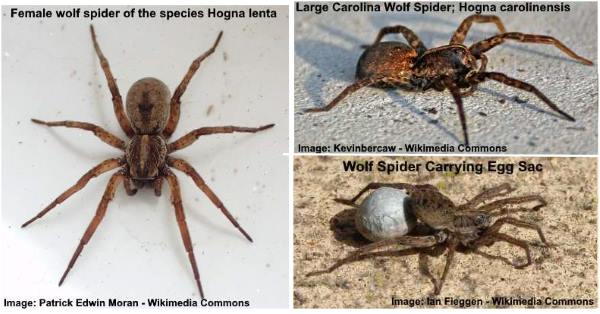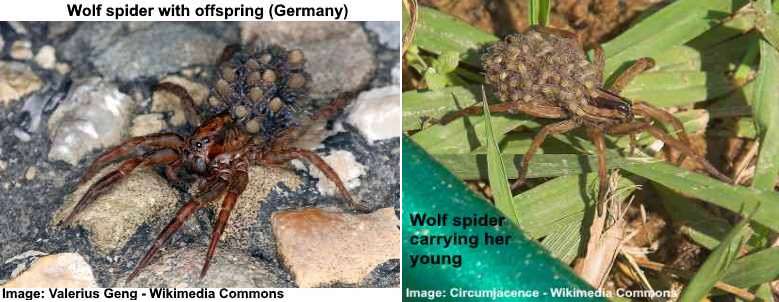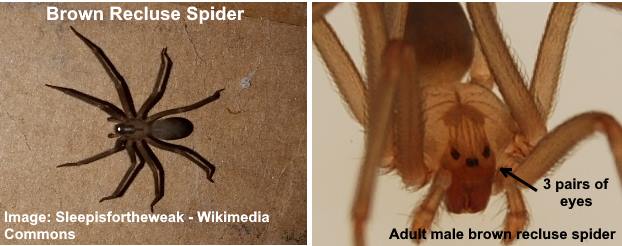Wolf Spider Bite: Effective Treatment Options and Identification

Most people have a strong aversion to all types of spiders, but seeing a wolf spider scurrying along the floor can be especially frightening. Wolf spiders can grow to just over an inch and look like small tarantulas, and if they get up close, can give you a nasty bite. A wolf spider’s bite on a human can leave a swollen red bump on the skin that can be quite painful.
Although the venom from a wolf spider’s bite can cause swelling and redness, home treatments are usually effective in alleviating the symptoms of its bite. Within 7-10 days the symptoms of the wolf spider’s bite should have gone away completely. However, because wolf spiders are similar in size and appearance to brown recluse spiders, you should monitor the effect of the bite. The bites from brown recluse spiders are more serious and should be examined by a doctor.
In this article, you will find out how to identify wolf spiders and what you should do if one happens to bite you or someone else.
How to Recognize Wolf Spiders
There are ways to distinguish wolf spiders from other species of spiders that find their way into our homes. According to the University of Nebraska-Lincoln, you can recognize wolf spiders by their distinctive eye pattern. First, you will notice two large eyes in the front of their head. Under those two eyes are a row of four smaller eyes. Wolf spiders also have two more eyes on the top of their head at either side.1
Species of wolf spiders range in size from small to relatively large in size. According to the PennState College of Agricultural Sciences, the largest species of wolf spiders grow to just over 1 inch in length. However, male wolf spiders are generally smaller than females and aren’t bigger than 1 inch.2
The University of Kentucky says that wolf spiders are generally large, quite hairy and fast-moving arachnids. They get their name from the way that they capture their prey. They don’t spin webs but hunt and ambush prey like wolfs do.3
Female wolf spiders carry their unborn young with them by attaching their round egg sac to the spinnerets at the end of the abdomen. Immediately after the young spiders emerge from the egg sac, they climb up their mother’s legs and crowd onto her.
Wolf spiders vs brown recluse spider
Wolf spiders can be difficult to differentiate from other spiders, especially the brown recluse spider. Brown recluse spiders tend to be thinner and less hairy than wolf spiders.
According to Dr. Jerry Balentine on eMedicineHealth, brown recluse spiders have a recognizable violin-shaped pattern on the part of the body that the legs attach to. Unlike wolf spiders, they only have 6 eyes (three pairs of eyes). However, their eyes are so small that you probably won’t see them.4
A bite from a brown recluse spider is more serious than a wolf spider’s bite. Dr. Balentine says that a brown recluse spider’s bite will cause severe pain, itching, vomiting, and muscle cramps. Sometimes, the bite symptoms can be so severe that, if not treated properly, blistering, scarring and tissue death around the bite can occur.
Do Wolf Spiders Bite?
Wolf spiders have large fangs that they use to bite their prey. According to the University of Kentucky, wolf spiders won’t attack humans but will only bite when they feel threatened or handled. So, to avoid getting bitten by a wolf spider, you should “herd” them into a container with a stick rather than picking them up with your hand.
Symptoms of Wolf Spider Bite
The good news is that symptoms of a wolf spider bites are no more harmful than a bee sting.3 Wolf spider bites can be treated in a similar way and don’t usually require any medical intervention.
The Journal of Toxicology reports that the most common symptoms of wolf spider bites are swelling, redness, itchiness, and discomfort around the bite. Depending on the severity of the bite, you may experience some bleeding where the fangs pierced the skin. In general, bites from wolf spiders cause minor effects and there are no reports of them causing necrotic ulcers.6
It may take for up to 10 days for a wolf spider bite to heal completely. However, if the pain continues for more than a few hours after the initial bite or you have a fever, muscle cramps, or blistering around the bite, you should visit your doctor immediately.
How to Treat Wolf Spider Bites Naturally
Wolf spider bites can be treated effectively with home remedies that provide topical relief. There are many natural ingredients that help to soothe inflamed and itchy skin and can help reduce redness and swelling.
Proper monitoring and treatment will help prevent spider bite complications and secondary infections infecting the bite wound.
Here are the necessary steps to treat wolf spider bites:
- Always wash your hands with antibacterial soap before attending to a spider bite.
- Apply a cold pack or cold towel to the affected skin area to help reduce swelling and prevent the spread of venom.
- Take note if the symptoms of the wolf spider bite appear to get worse in the first few hours after the bite.
- Visit your doctor if you experience any muscle pain, fever, nausea, or start vomiting.
- Use natural remedies such as witch hazel, chamomile, and aloe vera to help alleviate itchiness, reduce swelling and encourage faster healing of the spider bite.
Home Remedies for Relief from Wolf Spider Bites
In the event that a wolf spider bites you, you can use the following home remedies to help speed up the healing process and reduce the bite symptoms.
Cold compress
The best way to treat any kind of spider bite including wolf spider bite is to apply a cold compress to the affected skin area. Doctors from the Mayo Clinic recommend using a cool pack to prevent swelling and pain around the bite area.7 The cool temperature helps prevent blood rushing to the wound which can, in turn, cause the poison to spread further.
How to use:
- Soak a clean towel in cold water or put crushed ice in a plastic bag and cover with a towel.
- Apply the cold pack to the bite wound to help soothe the pain and reduce inflammation.
- Hold for 15-20 minutes once an hour for the first 6 hours to reduce discomfort caused by the wolf spider bite.
Baking soda
A baking soda remedy can help to draw out poison from the spider bite and keep the wound area free of infections. Because baking soda also acts as an anti-inflammatory agent, it will help to reduce itching and redness around the wolf spider bite.
Dr. David T. Derrer on WebMD says that baking soda is a good home remedy for insect bites and stings. It reduces any reaction to the spider bite and soothes the affected skin area.8
How to use:
To make your own home treatment for taking the sting out of a wolf spider bite, this is what you should do:
- Put 1 tablespoon of baking soda in a small bowl and add enough water to make a thick paste.
- Apply the baking soda treatment to the spider bite and let it sit for 15 minutes.
- Rinse off with warm water.
- Apply baking soda twice a day to the wolf spider bite to relieve the symptoms and repeat until all itchiness and redness have gone.
You can also use baking soda to clear up skin conditions like acne or you can simply use it in a natural face mask to get great, healthy-looking skin.
Apple cider vinegar
Another quick remedy to get rid of itching and inflammation from a wolf spider bite is to apply raw apple cider vinegar (ACV) to the wound. Due to its antiseptic nature, the acidic properties of ACV can help to prevent any infection making the wound worse. The low pH content of apple cider vinegar also helps to get rid of itchiness from the bite.
Apple cider vinegar contains acetic acid. According to the journal PloS One, acetic acid helps to lessen severe pain and itching in skin wounds. It also works as a topical antibacterial treatment to prevent the spread of infection.9
How to use:
Apple cider vinegar should always be diluted with water when using it to treat spider and insect bites. This is what you should do:
- Dilute raw, unfiltered apple cider vinegar with equal parts of water.
- Apply the natural remedy by dipping a cotton ball in the liquid and apply directly to the wolf spider bite.
- Leave to dry, then rinse off with warm water and pat dry.
- Apply the apple cider vinegar remedy 2-3 times a day to help the bite heal quicker.
Witch hazel
The astringent properties of witch hazel make it a great remedy to ease the discomfort and pain caused by wolf spider bites. Witch hazel contains tannins which help to constrict skin tissue and form a protective barrier over the wound.
The journal Advances in Dermatology and Allergology reported that witch hazel also soothes inflammation on the skin when applied topically.10 Dr. William Blahd on WebMD recommends using witch hazel as a first-aid treatment to reduce swelling from spider bites and insect stings.11
How to use:
To calm an itch in a spider bite and reduce redness, apply witch hazel directly to the affected skin area and this is what you need to do:
- Soak a cotton ball in pure witch hazel.
- Apply and hold on the affected skin area for 10 minutes to allow the astringent properties to speed up healing.
- Use the treatment 2 times a day and continue applying until signs of the wolf spider bite have gone for good.
Aloe vera
Nourishing aloe vera is a great remedy for many inflammatory skin ailments, including healing wolf spider bites. Aloe vera contains vitamins, enzymes, and minerals that help to keep your skin healthy and ease burning and itching.
Usually, the first sign of a wolf spider bite is inflammation where the fangs punctured the skin. Research into the anti-inflammatory actions of aloe vera has shown that it is a great remedy to treat the symptoms of insect bites. For example, the journal Skin Pharmacology and Physiology reported that aloe vera gel is as effective as 1% hydrocortisone cream in reducing inflammatory responses on the skin.12
According to doctors, 1% hydrocortisone cream is usually recommended to get rid of itching and redness from spider bites.13
How to use:
Instead of using hydrocortisone cream on the itchy bite, try using natural aloe vera to help the wolf spider bite heal quicker. For the home spider bite treatment, try to find aloe vera gel with a fewer added ingredients as possible.
- Apply aloe vera gel to the spider bite by gently massaging the gel into your skin and allow to dry.
- Repeat the treatment 2-3 times a day to help the wound heal well and moisturize your skin.
- Continue the process until all redness, swelling, and itchiness from the wolf spider bite wound have gone completely.
To boost the healing power of aloe vera, you can add some tea tree oil to it.
Tea tree oil
Tea tree oil is an amazing natural remedy for treating skin inflammation and infections. The healing power of tea tree oil comes from its natural antibacterial properties. You can use tea tree oil directly on a spider bite to reduce itching, swelling, and inflammation as a spot treatment. Or, you can add a few drops of tea tree oil to the other natural remedies in this article to accelerate the healing process of the wolf spider bite.
Many studies have confirmed the effectiveness of tea tree oil as a topical skin healing ingredient. For example, researchers published results of studies in the journal Clinical Microbiology Reviews. There it was found that tea tree oil inhibits inflammatory responses on the skin. Also, research has shown that tea tree oil prevents the spread of bacteria and viruses on the skin.14
How to use:
There are 2 ways to use tea tree oil to treat wolf spider bites. Firstly, you can put a drop or two of tea tree oil on the end of a cotton swab and apply directly to the affected skin area as a spot treatment. For the other home remedy, you can add tea tree oil to a carrier oil. This is what you should do to make the remedy at home:
- Add 2 to 3 drops of tea tree oil to a tablespoon of coconut oil or other carrier oil.
- Apply the tea tree oil remedy to the wolf spider bite and surrounding area by gently massaging the soothing oil into your skin.
- Use 2-3 times a day to keep your skin moist and free of infections.
Chamomile
Chamomile is another essential oil to treat wolf spider bites. Chamomile is well-known for its power to calm the mind; however, it is just as great at soothing skin inflammation caused by spider bites. When using chamomile essential oil to treat a bite wound, you should always mix it with a carrier oil like coconut oil, olive oil, or sweet almond oil.
Studies into using chamomile for skin disorders found that its anti-inflammatory properties are useful for treating bites. For example, extracts of chamomile are used topically for skin inflammation and irritations, wounds and insect bites.10
To use chamomile essential oil for wolf spider bites, you should follow the same recipe for tea tree oil but just use chamomile essential oil instead of the tea tree oil.
Calendula cream
Calendula, or pot marigold, can be used to take the itch out of spider bites and help soothe inflammation around the painful skin area. It is possible to make your own healing calendula salve for insect bites or you can buy a prepared natural cream.
The journal Pharmacognosy Review reported that there are many benefits of using calendula preparations on your skin. For example, it can help reduce itching, swelling, and pain from bite wounds, cuts, itchy skin, and prevent skin infections.15
To use calendula to soothe an inflamed wolf spider bite, mix 2-3 drops of calendula oil to a tablespoon of coconut oil. Apply the natural salve 2-3 times a day to help reduce inflammation, burning, and itchiness around the spider bite.
Honey
A little honey may do wonders for you and help treat a wolf spider bite to make it heal quicker. Honey is not just delicious to eat, but you can apply it to your skin to get rid of inflammation and clear up infections in wounds. Honey also provides a moist protective barrier to a spider bite wound to promote healing.
The Mayo Clinic reports that honey is often used to treat various types of wounds because of its antibacterial properties. When applied to wounds, evidence shows that honey reduces the healing time of wounds because it sterilizes infections.16
When using honey for its medicinal purposes, you should always use raw, organic unprocessed honey. All you should do is apply a little honey 2-3 times a day to help heal the wound from the spider bite.
You can also try Manuka honey as it contains even more skin-healing properties than regular honey.
How to Get Rid of Wolf Spiders for Good
Wolf spiders don’t usually infest homes. However, it’s not uncommon for one or two to find their way into your home where they can become a pest. One great and easy way to get rid of wolf spiders from your home is to make your own spider repellent.
Natural insect and spider repellents are great because they repel spiders but are not harmful to you or your family members and pets. Here is how to make your own wolf spider repellent with essential oils:
- Fill a spray bottle with 1 qt. (nearly 1 Liter) water and add a small squirt of liquid dish soap and 10-15 drops of essential oils. (Below you will see the best ones to use).
- Shake well to mix up the essential oils.
- Spray on areas of your home where spiders may get in.
- If you see a wolf spider scurrying across the floor, spray the remedy on the spider to kill it.
The best essential oils to make your own spider spray repellent are these:
Neem oil. A review of natural insect repellents found that neem oil is an effective repellent against various arthropods, is non-toxic to humans and doesn’t cause skin irritation.17
Citronella. The same report said that citronella is one of the most widely used natural repellents on the market.17
Cinnamon oil has been found to contain natural insecticides and it effectively repels various bugs, ants, spiders, and other creepy-crawlies.18
Mint oil. The strong smell of mint oil prevents spiders, ants, mosquitoes, and roaches from becoming pests in the house. It also has an insecticidal effect against bug larvae and can help eradicate pests from your home.19
Spider Bites – When to Call a Doctor
Although wolf spider bites won’t do any lasting harm, if you get bitten by a black widow or brown recluse spider, the effects can be more damaging. Therefore, you should closely monitor any kind of spider bite in the first few hours of being bitten.
According to doctors, if you have any of the following symptoms after a spider bite, you should seek medical help immediately:
- Pain gradually gets worse within an hour of being bitten
- The pain spreads to your back, abdomen, or chest
- You suffer abdominal cramping
- You have problems breathing and you feel as if your throat is closing up
- A blister forms at the bite site
- You suffer nausea and/or vomiting
- You have a fever with chills
- A skin rash develops over all your body
Read my other related articles:
- How to Get Rid of Spiders With Natural Spider Spray Repellents
- Cockroach Bites: Facts, Prevention and Simple Treatment Options
- How to Get Rid of Bed Bug Bites: The Most Effective Home Remedies
- Mite Bites: Warning Signs and Natural Treatments
Article Sources





